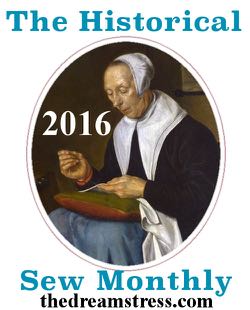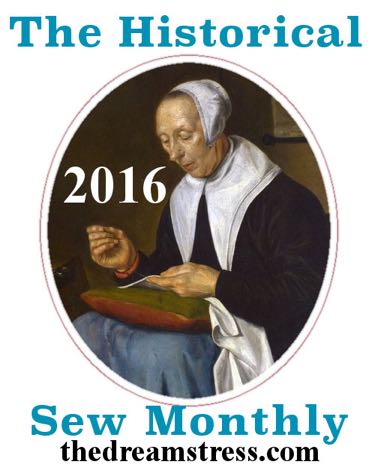One year, a challenge every month (due by the last day of the Month), and at the end of it, 12 fabulous historical garments.
How it works:
Every month in 2016 will feature a themed challenge and we’ll each sew (or knit, or crochet, or tatt, or embroider, or cobble, or whatever it is you call making a hat, or otherwise create) a historical garment or accessory that fits the theme.
For the purpose of the Historical Sew Fortnightly, ‘historical’ is Pre-WWII and earlier, so no later than 1938.
Because there are only 12 Challenges, Challengers are really encouraged to attempt to participate in every single challenge (though, obviously things do come up, and it’s better to participate in some than none!)
Your item can be as basic or elaborate as you want, from a simple fichu to fill in the neckline of a gown, to a full ensemble from the undergarments outward: whatever you need and can can handle time and skill-wise.
The HSF is meant to encourage research and historical accuracy, not fantasy or ‘costume.’
Of course, for many periods making a garment that is identical in every respect to a period garment is basically impossible. Even getting close can be quite expensive and physically demanding, which isn’t possible for everyone. Ultimately, the level of accuracy is really up to your needs, skills, and resources, as long as the item is in pursuit of greater historical understanding. There are also many ways to consider accuracy (you may find my post on how I approach it interesting), and we hope that the HSF will get people to think about accuracy, and how our relationship to what we wear and how we make it has changed over history.
You can start your project as early as you need to get it done in time — it doesn’t have to be done in the challenge month. However, as the HSF is meant to encourage new creations, your challenge item should be finished no more than one month before the challenge starts. (so the Feb Challenge can be an item finished Jan 1, but no earlier, etc.). Note that this is finished, not started, so you can start a project as far before a challenge as you wish.
Feel free to blog about the process of making your project, or use the HSF as an excuse to finish a UFO/PHd that you have already blogged about.
I’ll post pages with inspiration for each challenge, perhaps with a tutorial or links to helpful sites.
Some background posts about the HSF:
- The Historical Sew Fortnightly 2013
- The Historical Sew Fortnightly 2014
- The Historical Sew Monthly 2015
- How it started (or, the original post)
- Tips and Tricks for doing it (without going crazy)
- A discussion about the future of the HSF in 2015 — and my follow-up to that discussion
- Thoughts on what makes a garment historically accurate
How to participate:
- Join the Historical Sew Fortnightly group on Facebook. The challenges are listed as events, and you can choose to ‘attend’ them, chat with other attendees, get ideas, encouragement, and work through difficulties. Then, when your item is done, you can post photos in the album for each challenge, give a description, and link to an online photo album or a blog post if you have one. When you ask to join the HSF Facebook group one of the moderators or I will send you a message with a three questions for you to answer before we accept your request to join. Please make sure your account allows you to accept messages, and be sure to respond to our message.
Or…
- Participate through this page for the Historical Sew Fortnightly 2016 on my blog. Leave a comment with a link to your blog to let us know you are participating (please note, I’ll be going through every couple of months and checking links from comments and will delete comments from those who haven’t participated, so there aren’t a bunch of links to people who aren’t actually doing challenges). Grab the button below and post it in your sidebar. Be sure to link it to this page. With WordPress your html will look like this:<a href=” https://thedreamstress.com/the-historical-sew-monthly-2016/”><img src=”https://thedreamstress.com/wp-content/uploads/2015/12/HSM_2016_250_thedreamstress.com_.jpg” ></a> (unless, of course, you save the image to your computer and re-upload it, in which case your image address will look different).
 There is also page for each challenge linked through the challenge list below (links may not appear until close to the due date). Leave a comment on the page for the challenge with links to your blog post or online photo album to show off your creation, and so there is a record of what was created for each challenge.
There is also page for each challenge linked through the challenge list below (links may not appear until close to the due date). Leave a comment on the page for the challenge with links to your blog post or online photo album to show off your creation, and so there is a record of what was created for each challenge.
With each post or photo be sure to give your item a name/title and tell us:
The Challenge:
Material:
Pattern:
Year:
Notions:
How historically accurate is it?
Hours to complete:
First worn:
Total cost:
The Goals:
- To encourage collaborations and interactions in the historical costuming community;
- To encourage all of us to do more historical research, to improve our standards of historical accuracy, and to expand our historical sewing skills;
- To provide excuses to sew amazing garments from throughout history;
- To provide incentive to photograph and document these garments so they can be shared, appreciated and used for reference;
- And most of all…
- To have fun!
The Challenges:
- January — Procrastination – finish a garment you have been putting off finishing (a UFO or PHD) or make something you have been avoiding starting.
- February — Tucks & Pleating – make a garment that features tucks and pleating for the shape or decoration
- March — Protection – make something to protect yourself (from weather or injury) or your clothes (from soiling etc.)
- April — Gender-Bender – make an item for the opposite gender, or make an item with elements inspired by the fashions of the opposite gender
- May — Holes – sometimes the spaces between stuff are what makes a garment special. Make a garment that is about holes, whether it is lace, slashing, eyelets, etc. (note that the link takes you off this website, to fellow HSF admin’s blog Isis’ Wardrobe)
- June — Travel – make a garment for travelling, or inspired by travel. (note that the link takes you off this website, to fellow HSF admin’s blog Matsukaze Workshops)
- July — Monochrome – make a garment in black, white, or any shade of grey in between.
- August — Pattern – make something in pattern, the bolder and wilder the better.
- September — Historicism – Make a historical garment that was itself inspired by the fashions of another historical period.
- October — Heroes – Make a garment inspired by your historical hero, or your historical costuming hero.
- November — Red – Make something in any shade of red.
- December — Special Occasion: make something for a special event or a specific occasion, or that would have been worn to special event or specific occasion historically.


Dear Leimomi,
you didn’t do an inspirational post for the Monochrome Challenge, did you? Would you tell me where to link my contribution?
I hope, you have a pleasant journey and save return!
Regards,
Nora
It was done by one of her fellow moderators, and can be found here.
http://amostpeculiarmademoiselle.blogspot.co.nz/2016/06/historical-sew-monthly-monochrome.html.
While we’re at it, the Inspiration post for patterns can be found here: http://matsukazesewing.blogspot.com/2016/07/the-hsm-2016-challenge-no-8-patterns_24.html
I’m sure this page will be updated with links when she gets time 😉
Ack! Sorry, thanks for the reminder, now fully updated!
Thank you both!
[…] Historical Sew Monthly Challenge for October is to make a garment inspired by our historical hero, or our historical costuming […]
I am looking for a description of the following 1913 bridesmaid dress fabric “pale green floral dewdrop ninon over white charmeuse, Can you shed anything more than was listed in the paper? This was at my grandmother’s wedding, my own mother is 92, and wasn’t at the wedding…,
Ninon is a very lightweight, soft, gauze fabric – a true gauze, with a leno weave. So it would have been a very light floral fabric in green over lightweight white satin.
Dear Dreamstress. I am looking for dresses of the regency, empire time. Could you tell me a good shop in the net where find dresses to buy. I have an reenactment event at the beginning of june 2017 (tirol1809.jimdo.com) and i will need some dresses for a few ladies to participate the event. It is so difficult to find good dresses. In Austria it is almost impossible. Thanks. Regards Marcus Autherith